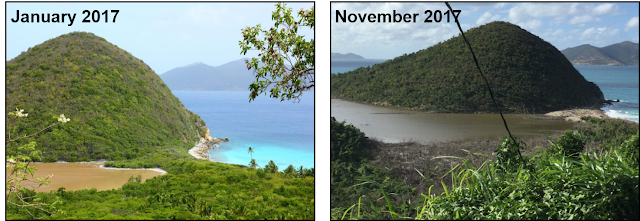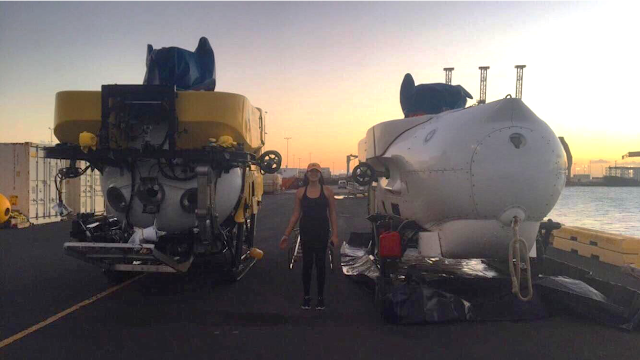Recovery Times After Catastrophic Events in the Caribbean Islands
by Josh Mueller
Natural Threats to Caribbean Islands
Hurricanes throughout the Caribbean are recognized as the dominant ecological cause of ecosystem and economic disruption [1, 2]. For example, recent storms such as hurricane Irma in September 2017 broke records of sustained hurricane size and wind speed for Atlantic Ocean tropical depressions. Irma caused significant economic damage with estimates in the range of over $100 billion in costs and damages throughout the Caribbean islands (Figure 1). The hurricane also resulted in over 130 human casualties making it one of the deadliest and costliest ever recorded. Yet, what remains unknown are the lingering economic and ecological costs from ecological threats to many of the island nations whose markets depend greatly on the tourism industry. Additionally, little is known regarding the future behavior of hurricanes as global climate change continues to influence atmospheric and oceanic conditions.
Wildfires, both naturally occurring and human induced, have also been a dominant hazard to the Caribbean islands, particularly during the 15th and 16th centuries when English and Dutch explorers began to colonize the British Virgin Islands (BVI) [2]. Throughout this period, colonists introduced cash crops and production via aggressive and destructive burning techniques to clear the landscape for sugarcane, corn, and tobacco. Such agricultural methods can drastically alter natural vegetation and fire regimes for island ecosystems. But through paleoecological research, it is possible to gain insight into how impactful prehistoric hurricanes and human activities were on Caribbean ecosystems, and the necessary time needed for island ecosystems to recover after catastrophic disturbances, such as hurricane Irma.
Paleoecological Insight
Recent scientific breakthroughs from a paleoecological research team out of the Natural History Museum of Utah [2] has provided critical insight into the time it will take for BVI ecosystems to recover and return to their ‘pre-damaged’ conditions. They discovered that European colonists explicitly targeted larger islands (Tortola) over smaller islands in the BVI (Figure 2), viewing them as optimal settings to initiate cash crop production due to the larger landmass; Tortola being the largest, Beef Island the mid-sized, and Thatch being the smallest island. Agricultural activities were demonstrated by an increase in charcoal particle concentrations (a proxy for fire activity) found within coastal sediment cores collected from each of the three islands (Figure 3). Tortola showed increases in fire activity at the early onset of European colonization in the 15th century, followed by similar increases in fire activity on Beef Island, and finally fire increases are seen latest in time at the smallest island, Thatch Island. Researchers also found that the rapid burning employed by Europeans had serious impacts on the native vegetation on the landscape. The authors point out that recovery times for mangrove forests and coastal swamps, which are two dominant vegetation types found on the islands, are typically around a century to return to ‘pre-disturbed’ conditions [2]. Being that both mangrove forests and coastal swamps are location near pristine Caribbean beaches, understanding how long these ecosystems will take to recover, and if they will return to a ‘pre-hurricane state’ is a vital for tourism and economic stimulation. The authors also point out that early successional species such as Saltwort (Batis Maritima) may promote and stimulate mangrove growth and establishment.
Lasting Impacts
The findings from this research are particularly significant because so much of the BVI economy is dependent upon the influx and growth of the tourism industry. Tourists are drawn to the Caribbean islands for their pristine warm waters, coastal vegetation, scenic views, and white sands that they have either seen on Google image searches or seen on past holidays. However, tourists may not see exactly or experience the images seen online as the islands are currently experiencing a fundamental recovery period from hurricane Irma [2]. Yet, it is critical for the economies of these island nations, as well as for the ecological recovery efforts, such as the mangrove restoration program through the BVI Parks Trust, that tourists return to these islands and spend money. Particularly if they want to see the islands return to their ‘natural state’. The British Virgin Islands are open to tourism again, they are recovering, and they remain a stunning location to visit!
Josh Mueller, Ph.D.
Academic Staff, Department of Geography, University of Wisconsin-Oshkosh
If you have questions or comments concerning Josh's post, please leave a comment below, or send him an email. You can also connect with him on Twitter and follow his research on ResearchGate.
_____________________________________________________
[1] Liu, K-B and Fearn, ML (1993). Lake-sediment record of late Holocene hurricane activities from coastal Alabama. Geology 21, 793-796.
[2] Mueller, JR, Power, MJ, Long, CJ (2018). Climate and human influence on Late- Holocene fire regimes in the British Virgin Islands. Quaternary Research. 12, 1-15.
Natural Threats to Caribbean Islands
Hurricanes throughout the Caribbean are recognized as the dominant ecological cause of ecosystem and economic disruption [1, 2]. For example, recent storms such as hurricane Irma in September 2017 broke records of sustained hurricane size and wind speed for Atlantic Ocean tropical depressions. Irma caused significant economic damage with estimates in the range of over $100 billion in costs and damages throughout the Caribbean islands (Figure 1). The hurricane also resulted in over 130 human casualties making it one of the deadliest and costliest ever recorded. Yet, what remains unknown are the lingering economic and ecological costs from ecological threats to many of the island nations whose markets depend greatly on the tourism industry. Additionally, little is known regarding the future behavior of hurricanes as global climate change continues to influence atmospheric and oceanic conditions.
 |
| Figure 1. Belmont Pond on the island of Tortola. Left image is from March 2015, before impacts from Irma. Right image is from January 2018, after the impacts of Irma |
Wildfires, both naturally occurring and human induced, have also been a dominant hazard to the Caribbean islands, particularly during the 15th and 16th centuries when English and Dutch explorers began to colonize the British Virgin Islands (BVI) [2]. Throughout this period, colonists introduced cash crops and production via aggressive and destructive burning techniques to clear the landscape for sugarcane, corn, and tobacco. Such agricultural methods can drastically alter natural vegetation and fire regimes for island ecosystems. But through paleoecological research, it is possible to gain insight into how impactful prehistoric hurricanes and human activities were on Caribbean ecosystems, and the necessary time needed for island ecosystems to recover after catastrophic disturbances, such as hurricane Irma.
Paleoecological Insight
Recent scientific breakthroughs from a paleoecological research team out of the Natural History Museum of Utah [2] has provided critical insight into the time it will take for BVI ecosystems to recover and return to their ‘pre-damaged’ conditions. They discovered that European colonists explicitly targeted larger islands (Tortola) over smaller islands in the BVI (Figure 2), viewing them as optimal settings to initiate cash crop production due to the larger landmass; Tortola being the largest, Beef Island the mid-sized, and Thatch being the smallest island. Agricultural activities were demonstrated by an increase in charcoal particle concentrations (a proxy for fire activity) found within coastal sediment cores collected from each of the three islands (Figure 3). Tortola showed increases in fire activity at the early onset of European colonization in the 15th century, followed by similar increases in fire activity on Beef Island, and finally fire increases are seen latest in time at the smallest island, Thatch Island. Researchers also found that the rapid burning employed by Europeans had serious impacts on the native vegetation on the landscape. The authors point out that recovery times for mangrove forests and coastal swamps, which are two dominant vegetation types found on the islands, are typically around a century to return to ‘pre-disturbed’ conditions [2]. Being that both mangrove forests and coastal swamps are location near pristine Caribbean beaches, understanding how long these ecosystems will take to recover, and if they will return to a ‘pre-hurricane state’ is a vital for tourism and economic stimulation. The authors also point out that early successional species such as Saltwort (Batis Maritima) may promote and stimulate mangrove growth and establishment.
Lasting Impacts
The findings from this research are particularly significant because so much of the BVI economy is dependent upon the influx and growth of the tourism industry. Tourists are drawn to the Caribbean islands for their pristine warm waters, coastal vegetation, scenic views, and white sands that they have either seen on Google image searches or seen on past holidays. However, tourists may not see exactly or experience the images seen online as the islands are currently experiencing a fundamental recovery period from hurricane Irma [2]. Yet, it is critical for the economies of these island nations, as well as for the ecological recovery efforts, such as the mangrove restoration program through the BVI Parks Trust, that tourists return to these islands and spend money. Particularly if they want to see the islands return to their ‘natural state’. The British Virgin Islands are open to tourism again, they are recovering, and they remain a stunning location to visit!
 |
| Field work photo showing sediments collected from Belmont Pond, Tortola in January 2017 |
Josh Mueller, Ph.D.
Academic Staff, Department of Geography, University of Wisconsin-Oshkosh
If you have questions or comments concerning Josh's post, please leave a comment below, or send him an email. You can also connect with him on Twitter and follow his research on ResearchGate.
_____________________________________________________
References:
[2] Mueller, JR, Power, MJ, Long, CJ (2018). Climate and human influence on Late- Holocene fire regimes in the British Virgin Islands. Quaternary Research. 12, 1-15.



Fascinating perspective and study!
ReplyDelete